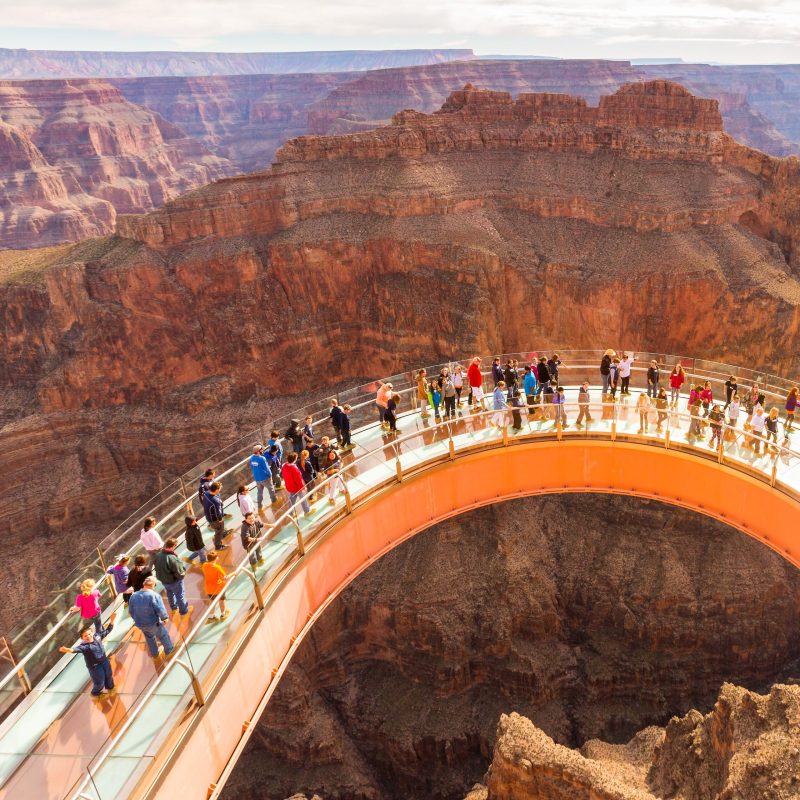
A setting right at the edge of a natural wonder combined with a glass-floored bridge that offers an up-close-and-personal encounter: What’s not to love?
Videos by TravelAwaits
For enthusiasts of the Grand Canyon, the chance to safely venture beyond the ledge is definitely tempting. But is the allure of that one-of-a-kind experience enough to warrant an hours-long trip on remote highways?
For me, a visit to the Grand Canyon Skywalk was a prime example of the old adage that it’s more about the journey than the destination.
That’s not to say that the Skywalk itself isn’t a cool experience. Walking out onto the glass-floored bridge that extends 70 feet out over the spectacular chasm gives you a perspective that is hard to duplicate.

Even though the canyon’s rocky ridges and leafy trees are hundreds of feet below, it seems that you could almost reach out and touch them as you peer down through the glass. And the bridge is a lovely vantage point from which to take in the opposite side of the canyon.
But the real fun of the visit was in the drive there and the other stops along the Grand Canyon West shuttle route.
Although I enjoyed the Skywalk, the experience is fairly brief, and there isn’t a lot to do once you get out there. The attraction promoters obviously anticipated that, though, and Grand Canyon West offers a lot more than just the Skywalk.
To help you determine whether the trip would be worth it for you, here’s a breakdown of what works and what doesn’t.

The High Points
On the far-corners-of-the-world scale, Grand Canyon West scores high. If you’re looking for a destination that seems a bit wild and isolated, this trip could be for you.
For travelers accustomed to the Grand Canyon National Park’s South and North Rims, the western edge of the canyon is a revelation. At 241 miles west of the South Rim, Grand Canyon West will open your eyes to the breadth and scale of the canyon.
Although the main route to the Skywalk is along well-maintained, paved roads, it can feel a little remote — in a good way. The road curves through beautiful high-desert terrain and offers sweeping views of jagged mountains in the distance.
At upwards of 2 hours from the nearest city, the Skywalk is a trek regardless of where you’re coming from. Fortunately, there are features that will surprise and delight you along the way.
Here are some reasons to consider a trip to the Skywalk.

Cindy Barks
Guano Point Is Stunning
Once you arrive at the Skywalk ticketing center and show your ticket, you will be routed onto a shuttle bus that will eventually get you to the main attraction. But there are a couple of other stops along the way.
Hualapai Ranch, the shuttle’s first stop, feels completely staged, with its roping and shooting demonstrations and bucking bronco statues. Unless you have young children, the faux-Western village is probably worth little more than a walk-through.
Luckily, the best stop of the trip is still to come. After taking you to the Skywalk, the shuttle will drop you at Guano Point, a gorgeous outcropping of red rocks that overlooks the Little Colorado River Gorge.

Cindy Barks
Walking trails encircle the mound of rocks and take you to the far point, where the remains of an old mining operation stand in stark contrast to the blue sky. A sign at the mine explains that the structure was built in the 1950s to mine guano (bat droppings), which is rich in nitrogen and used for fertilizer. The operation included a tramway and cable cars for the guano and the miners. After the cable was damaged in 1960, the mine was abandoned. Today, the skeletal remains are a part of the point’s appeal.
After a walk along the rocky trails, visitors can get refreshments at the Guano Cafe and rest under the shade structure in the large outdoor seating area that overlooks the canyon.

Cindy Barks
You’ll See Joshua Trees
As you drive along Arizona Highway 93 toward Grand Canyon West, a magnificent little pocket of spiky Joshua trees will command your attention.
Known as the Arizona Joshua Tree Forest, the stand of high-desert trees makes a great place to stop and stretch your legs before proceeding on to the final stretch of the drive. Time your trip right (from February through late April), and you might spot the Joshua trees in bloom with waxy yellow flowers.
The Skywalk Is Accessible
With only glass between you and the scene hundreds of feet below, expect to feel a bond with the Grand Canyon while standing on the Skywalk.
In fact, it’s the next best thing to hiking the natural wonder. And since there are many people who are physically unable to take even a short hike into the Grand Canyon, the Skywalk offers a wonderfully accessible alternative.

Cindy Barks / Grand Canyon West
The Downsides
Ever since the Hualapai tribe opened the Skywalk in 2003, the attraction has generated its fair share of debate about its cost, its far-flung location, and its value.
Here are a few common complaints about the Skywalk.
It’s Remote
Located more than an hour from the Interstate 40 town of Kingman, Arizona; about 2 hours from Las Vegas; and more than 4 hours from Phoenix, the Skywalk is quite remote. If you’re not up for a long drive, or if you think the desert is dreary and forbidding, the Skywalk probably isn’t for you.
Also, depending on the season, the drive could be piping hot, so visitors are advised to carry plenty of water and to service their cars before setting out.
No Cameras Are Allowed
The views may be stunning from the Skywalk, but you won’t be able to record your own memories. Cameras and cell phones are prohibited on the Skywalk.
The stated reason is that cell phones, cameras, and other equipment could scratch the Skyway’s glass. The rule is strictly enforced. You will be asked to put your belongings in a locker, and then you will be required to go through a metal detector before entering the Skywalk.
If you really want a photo on the Skywalk, you can get in line for a photographer who will ask you to strike a number of poses — gazing at the Canyon, doing a thumbs-up, and throwing your arms high over your head. Single photos or digital packages containing all of the dozen or so poses are available for purchase after you leave the Skywalk.
It’s Expensive
The packages for the Skywalk don’t come cheap. If you add in photos and refreshments, you could be looking at a fairly pricey excursion. Especially for family groups of three or four, the costs can add up to several hundred dollars.
The high cost of the Skywalk is the most frequently cited complaint on travel websites. For me, the admission was worth the price because of the other features that came with it.
After viewing the Grand Canyon from many of the South and North Rim vantage points and trails over the years, it was fascinating to see another side of the canyon and the Colorado River.
So, if you’re looking for a new perspective on the Grand Canyon, the Grand Canyon West is definitely the place to get it.

Options That Offer A Similar Thrill
If it’s the thrill of being perched over the ledge of the canyon that you’re after, there are plenty of viewpoints that offer a similar effect without the lines or expense of the Skywalk.
The issue with many of the best viewpoints, however, is that you’ll have to hike miles over rough terrain to get there.
But if you’re up for a physical challenge and are fit enough to pull it off, here are a couple of hikes that will give you the feeling that you’re soaring over the canyon — minus the glass barrier.
Plateau Point, South Rim
For views from atop the Colorado River, Plateau Point on the Grand Canyon’s South Rim is unparalleled.
Like the Skywalk, Plateau Point features a view that is virtually straight down to the river. But unlike the Skywalk, Plateau Point requires a strenuous 12-mile round-trip hike.
Still, if you prefer your views of the Colorado River from a rocky bluff in a remote spot that is mostly frequented by Kaibab squirrels, Plateau Point would be your best bet. The point is accessible from the South Rim’s Bright Angel Trail. The Grand Canyon National Park charges a per-car admission.
Uncle Jim Trail, North Rim
For a superb straight-down view, the Uncle Jim Trail at the North Rim is hard to beat. The 5-mile loop trail will take you to Uncle Jim Point, a spot with the winding switchbacks of the North Kaibab Trail and the Roaring Springs spread out far below. The fairly easy trail along the North Rim also takes in forests and small valleys before reaching the viewpoint. Please note that the road to the North Rim is closed during the winter months.
